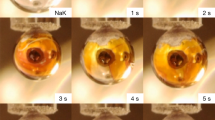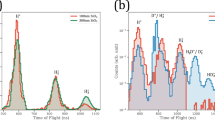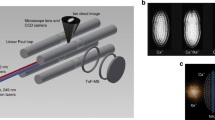Abstract
BY pulse radiolysis of aqueous solutions at room temperature, new absorption bands for H, OH, D, OD and eaq− in the ultraviolet region down to 188 nm have been observed1,2 and recently confirmed3. The favoured interpretation was a redshift of the absorption band of water caused by perturbation by the solutes (H, D, eaq−) similar to the β-band displacement in alkali halide crystals1. It was also suggested that such a band may exist in liquid ammonia, implying that it is a general phenomenon associated with the solvated electron. Furthermore, the transient spectrum obtained by pulse radiolysis of pure liquid ammonia (−45 °C) shows, in addition to the broad infrared absorption of the solvated electron, two unidentified bands in the ultraviolet region4. To study optical properties in this range, we chose metal–ammonia solutions which are relatively stable although their decomposition leads to the amide ion which itself absorbs strongly in the same region. Our findings strongly support the hypothesis, though amide and hydrogen are the only products and have been thoroughly studied.
This is a preview of subscription content, access via your institution
Access options
Subscribe to this journal
Receive 51 print issues and online access
$199.00 per year
only $3.90 per issue
Buy this article
- Purchase on Springer Link
- Instant access to full article PDF
Prices may be subject to local taxes which are calculated during checkout
Similar content being viewed by others
References
Hart, E. J., Nielsen, S. O., and Pagsberg, P., J. phys. Chem., 73, 3171–3172 (1969).
Pagsberg, P., Christensen, H., and Rabani, J., J. phys. Chem., 73, 1029–1038 (1969).
Nielsen, S. O., Michael, B. D., and Hart, E. J., (in the press).
Belloni, J., Cordier, P., and Delaire, J., Chem. Phys. Lett., 27, 241–244 (1974).
Belloni, J., and Saito, E., Electrons in Fluids (edit. by Jortner, J., and Kestner, N. R.), 461–471 (Springer-Verlag, New York, 1973).
Belloni, J., and Fradin de la Renaudiere, J., Int. J. Radiat. Phys. Chem., 5, 31–39 (1973).
Cuthrell, R. E., and Lagowski, J. J., J. phys. Chem., 71, 1298–1301 (1967).
Corset, J., and Lepoutre, G., J. chim. Phys., 63, 659–662 (1966).
Copeland, D. A., Kestner, N. R., and Jortner, J., J. chem. Phys., 53, 1189–1216 (1970).
Fueki, K., Feng, D. F., Kevan, L., and Christoffersen, R., J. phys. Chem., 75, 2297–2305 (1971).
Fueki, K., Feng, D. F., and Kevan, L., J. Am. chem. Soc., 95, 1398–1407 (1973).
Author information
Authors and Affiliations
Rights and permissions
About this article
Cite this article
BILLIAU, F., BELLONI, J. & SAITO, E. Ultraviolet absorption by metal–ammonia solutions. Nature 263, 47–48 (1976). https://doi.org/10.1038/263047a0
Received:
Accepted:
Issue Date:
DOI: https://doi.org/10.1038/263047a0
Comments
By submitting a comment you agree to abide by our Terms and Community Guidelines. If you find something abusive or that does not comply with our terms or guidelines please flag it as inappropriate.



